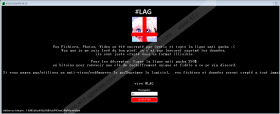Vivelag Ransomware Removal Guide
If you speak French and use Windows, Vivelag Ransomware is the infection that you need to be cautious about right now. While there are hundreds and thousands of infections that work just like this particular threat, it has a more narrow focus on who it targets. So, if you live in a French-speaking country, you might be the preferred target. Due to this, it is possible that this malware could be spread via specific file-sharing websites or using French spam emails. In any case, you have to be careful about all unreliable file-sharing websites, all emails, and certainly all unpatched vulnerabilities. You also need to be careful about how you secure your operating system. While you might be able to recognize malware before it executes, if you are tricked, and your system is not prepared to fend off malware, you are in big trouble. At that point, even deleting Vivelag Ransomware cannot save you.
When Vivelag Ransomware encrypts your files, it attaches the “.VIVELAG” extension to their names. The data of these files is scrambled, and that is why you cannot read them normally. Unfortunately, legitimate file decryptors cannot do that either. Perhaps that will change in the future, but we do not know that for sure. Unfortunately, ransomware is strong exactly because the attackers are usually able to employ strong, undecipherable encryption algorithms. This might be the reason why Avaddon Ransomware, WCH Ransomware, SIGARETA Ransomware, MOOL Ransomware, and Vivelag Ransomware itself are among thousands of other threats alike. While they might encrypt files differently, they all want something. In some cases, that is to humiliate the victim or stall them. In most cases, however, encryptors are built to make money. When the Vivelag variant is done with the encryption of files, it disabled the Task Manager to make it impossible for you to terminate a malicious process and, eventually, perform removal. That is also when the “RANSOMWARE#LAG” window pops up.
The message represented via this Window is in French, and it suggests that all important personal files were encrypted by someone who calls themselves “Dystic” and the “anti-gacha league.” The request within the message is simple: You contact the attacker via Discord and pay a ransom of $250, or all files are deleted. The message also warns not to employ anti-virus software, restart the computer, or remove the infection. Most likely, nothing would happen if you restarted the system or removed Vivelag Ransomware, but you might not want to take any risks. After all, it is your personal files that are on the line. Ideally, you have backups set up, and you have copies of all important files stored somewhere safe, like a secure virtual cloud or an external drive. If backups exist, you can replace the corrupted files after deleting the infection. In the future, make it a point of yours to always create backups of all important files. After all, Vivelag Ransomware is not the only file-encryptor, and ransomware is not the only kind of malware that can affect your files. There are some infections that instantly wipe systems or destroy files by accident. You want to prepare for that.
Of course, you should not sit and wait for another malicious threat to invade your operating system. Instead, you should take matters into your own hands. First and foremost, you want to implement security software that could reliably protect your entire operating system, and not just system or personal files. After the anti-malware software you employ successfully removes Vivelag Ransomware, you also must not forget to update it to keep it running smoothly and efficiently. Speaking of updates, you must not forget to install all of them and in time. If you wait, cybercriminals could find a way to exploit vulnerabilities for malware distribution or data leaks. If you are currently more interested in the manual removal of Vivelag Ransomware, we have to warn that the file that you must eliminate could be pretty much anywhere. The guide below lists a few potential locations, but we cannot guarantee that this is where you will find the infection. Note that you can always use a malware scanner to check your progress.
How to delete Vivelag Ransomware
- Tap Win+E keys to open File Explorer.
- Enter the following linesinto the quick access field at the top, one by one:
- %TEMP%
- %USERPROFILE%\Desktop
- %USERPROFILE%\Downloads
- If you find and identify malicious files, you must Delete them immediately.
- Exit File Explorer and then Empty Recycle Bin.
- Run a full system scan using a legitimate malware scanner tool.
Vivelag Ransomware Screenshots:


